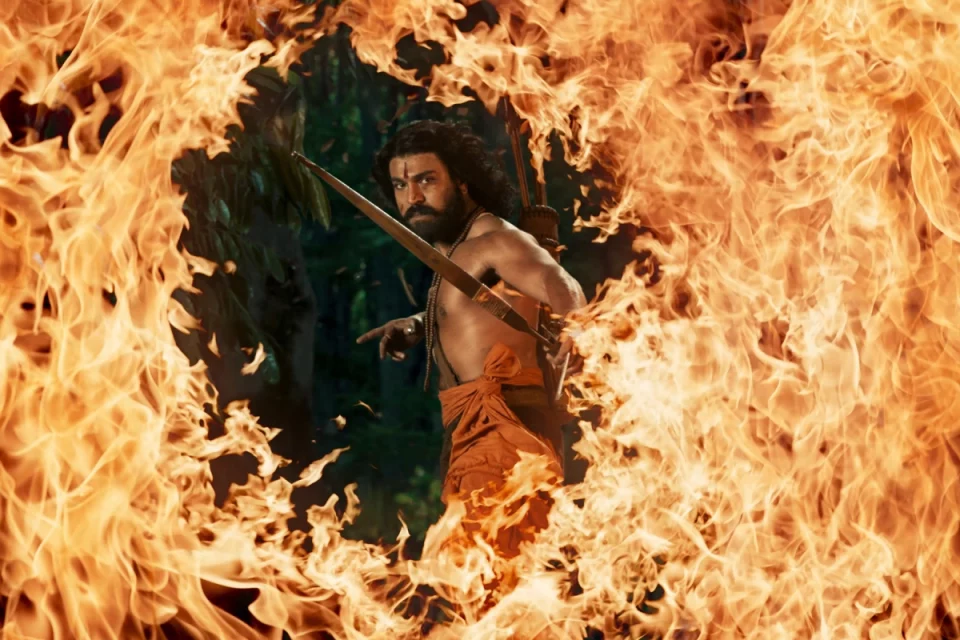‘RRR’ Is the Best — and Most Revolutionary — Blockbuster of 2022
The record-breaking, anti-colonialist Indian action movie returns to theaters for one night only — and if any movie ever deserved to be seen on a giant screen with a crowd, it’s this one
It’s tough to pinpoint the exact moment that the movie hooks you; mileage will vary per viewer. For some, it might be right from the get go, during a Melodrama 101 preamble involving a kidnapped child and casual colonial cruelty that leaves corpses in its wake. Others may find themselves leaning forward when a supercop, sporting the world’s most luxurious old-timey mustache, single-handedly beats back a crowd of thousands to catch a rock-throwing culprit. Or maybe the sight of a ripped, shirtless man sprinting through a forest and narrowly avoiding a midair collision between an angry wolf and an even angrier tiger is your investment tipping point.
Don’t worry: Should you somehow not find yourself entertained or exhilarated within the first 20 minutes or so of RRR, a.k.a. one-ninth of this film’s running time, stick around. There’s more. A lot more. Like an emergency rescue mission involving a sinking raft, a flaming train, a horse, a motorcycle, some rope and the flag of India. And a siege on a diplomat’s mansion punctuated by a CGI menagerie tearing into the British Raj’s troops. And the most frenetic, kinetic, class-conscious dance-off to ever double as a cultural fuck-you. And bromantic montages, slo-mo brooding, flashbacks that constitute their own short films, a man kicking an arrow through a tree trunk into another man’s head, and an acrobatic sequence involving a hero leaping, fighting and shooting legions of enemy soldiers while perched on his best friend’s shoulders that would make Butch and Sundance slow-clap.
A subversive, supersized screed set in 1920’s Delhi, the latest film from the Telugu writer-director S.S. Rajamouli — its title RRR means different things depending on what translated version you see, but the Hindi cut opts for “Rise, Roar, Revolt” — has already broken box office records in India and earned a rapidly growing cult following everywhere else, notably the States. Its tale of Rama (Ram Charan), a dogged police officer going undercover for the British Raj, and Bheem (N.T. Rama Rao Jr., a.k.a. Jr. NTR), the rural revolutionary he’s hunting, features two of the country’s modern megastars and pulls liberally from the nation’s tempestuous 20th century history, ancient folklore and Hindu mythology, notably the two Sanskit epics Mahabarata and Ramayana. Even if you’re familiar with the “Tollywood” industry’s output, India’s action flicks and/or Rajamouli’s past works (notably the Baahubali movies), the breakneck pacing, go-for-broke set pieces and sheer volume of plot surprises will still manage to blow your hair back. For the many moviegoers who aren’t, especially in the West, this three-hour extravaganza of sound and fury will serve as a gateway drug to a whole subset of world-cinema pop narcotics.
While the Hindi-dubbed version has been streaming on Netflix for several weeks now (it’s currently listed as the most-streamed non-English movie on the site, but given how these “stats” are never corroborated by outside sources, it’s best to take this announcement with a boulder-sized grain of salt), Variance Films is giving the movie another one-night-only “encoRRRe” in theaters, which is your only chance to catch the movie in its original, Telugu-language form. We can’t guarantee you’ll get something like this, but we can assure you that you will experience something close to popcorn-movie bliss. It’s like mainlining a dozen genres and narratives at once: old-school David Lean epics, ’80s Hollywood he-man pulp, ’90s Bollywood musicals, Hong Kong action movies, Russian silent cinema, Italian peplum, Passion plays, Homeric odysseys and homoerotic buddy comedies.
It bears mentioning that, for those who may know next to nothing about the real-life martyrs these characters are based on, or whether Rajamouli and Co.’s way of playing fast and loose with the facts regarding these freedom fighters muddies the waters around India’s contemporary sociopolitical concerns, RRR does run the risk of being one long, context-less adrenaline rush. Its bad guys are clearly the sadistic British imperialists, easily read as occidental occupiers who must be overthrown as well as stand-ins for a host of other IRL colonial powers on other continents, in other centuries. These villains earn their comeuppance before the end credits as much as the heroes earn their victory laps. Rajamouli has dropped the term “unity” a lot in press interviews. But by the time you get to its post-climax celebratory musical number, which drops the historical pretense and indulges in the kind of political pageantry you associate with North Korea, you wonder just how much of this skews into the realm of nationalistic propaganda. There are moments when you wonder if your cheering comes with a “citation needed” footnote attached. (It immediately sent me deep-diving into India’s post-liberation history, which — to put it mildly — is complicated.)
And yet, there’s a lingua franca here that cuts across the fear that you’ve either been seduced by something you only partially comprehend or are simply reacting to the thrill of new, steroidal exotica. More than anything, RRR is about the movies: the thrill of watching stories told at larger-than-life levels, the joy of watching stars collide (with each other and CGI tigers), the effort of rendering lavish mythologies at whatever the digital equivalent of 24 frames per second is, the sensation of seeing manufactured movement via gleefully conspicuous special effects bump up against genuine physical effort. (Seriously, the “Desi Naach” dance sequence feels like a Gene Kelly number dialed up to superhuman levels.) To call this the best blockbuster of 2022 is only partially accurate; it’s really several of the best blockbusters, plural, you’re apt to catch this year. And if ever a movie deserved to be seen with a crowd and on the largest screen imaginable, it’s this one.

From Rolling Stone US.








